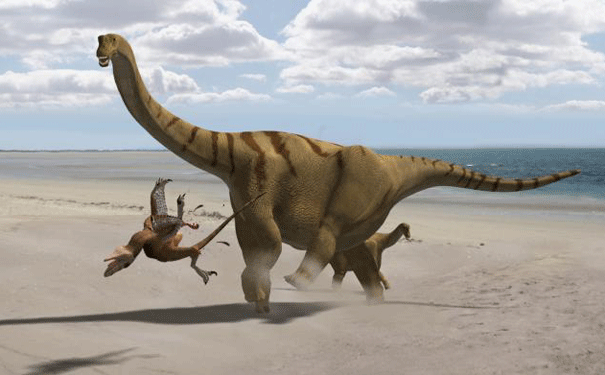
A life restoration of a Brontomerus. Image: Francisco Gascó
Brontomerus mcintoshi has been named after its enormously powerful thigh muscles.
The fossilised bones from two Brontomerus mcintoshi – an adult and a juvenile- have been taken from a previously damaged and looted site in Eastern Utah. The larger specimen, suggested to be the mother of the smaller, would have measured 14 metres and weighed approximately six tonnes, while the juvenile weighed roughly 200 kilograms and would have been 4.5 metres long.
The hip bone of the Brontomerus is unusually large when compared to those of similar dinosaurs, projecting forward from the hip socket to provide a huge area for muscle attachment. The dinosaur would have had the largest leg muscles of the sauropod family, earning it it’s name.
Dr Mike Taylor, University College London, said in the press release “When we recognised the weird shape of the hip, we wondered what its significance might be, but we concluded that kicking was the most likely. The kick would probably have been used when two males fought over a female, but given that the mechanics were all in place it would be bizarre if it wasn’t also used in predator defence.”
This find is one of many in the last 20 years that has challenged the theory that sauropods began to die out during the early Cretaceous. “Because sauropods were the most abundant dinosaurs found during the Jurassic period and the rarest during the Early Cretaceous, there’s long been the perception that sauropods were successful in the Jurassic and were replaced by duckbills and horned dinosaurs in the Cretaceous,” explained Dr Wedel, Western University of Health Sciences, in the press release.
“In the past 20 years, however, we are finding more sauropods from the Early Cretaceous period, and the picture is changing. It now seems that sauropods may have been every bit as diverse as they were during the Jurassic, but much less abundant and so much less likely to be found.”






